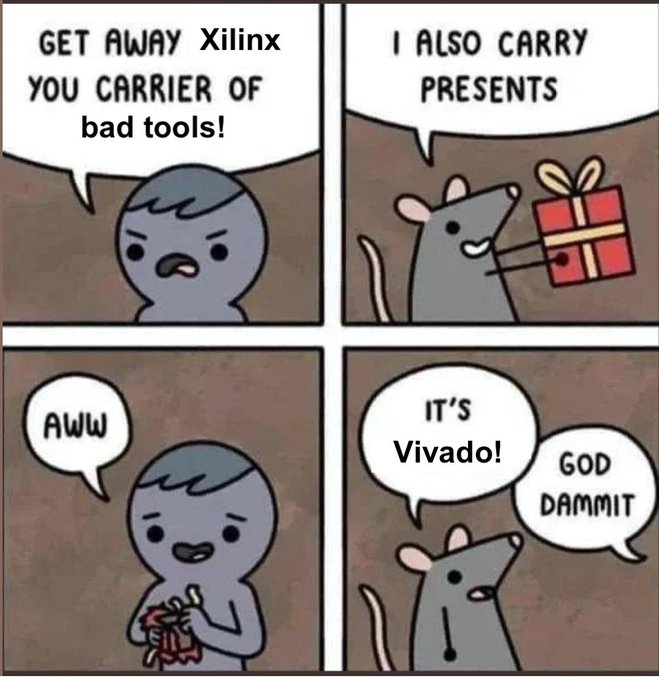Tiny Tapeout Course 2nd lesson - FPGAs
Paul Campbell - March 2023
paul@taniwha.com @moonbaseotago

(C) Copyright Moonbase Otago 2023
All rights reserved
Before you start
Install on your laptop:
Vivado is big, a full install is ~60Gb, you can get it down to ~20Gb if you just install what's required for the Arty boards
(I understand that Mac users may have to do this in a VM)
Things to Learn
- Making a chip
- Driving Vivado
Making a chip
We talked last time about how to take a verilog design and compile it into a form where we can simulate a circuit, now we're going to compile one into gates and load it into an FPGA - there are 3 basic steps
- Synthesis - convert a verilog design into gates and wires
- Place and route aka 'P&R' (usually done in the order):
- Physically place the gates
- Route the wires between them
All of these are timing driven with the tools calculating the delays through and between gates - synthesis has to guess at wire delays, it can change the gates it produces to make things faster, place and route can move things around to make them faster.
Gate libraries
When we're building a chip we normally start with a gate library - this is a group of 'gates' - often hand made physical designs, usually they are all the same height (so that the power rails hook up in the metal1 layer).
Libraries usually contain something like:
- flip-flops
- buffers and inverters of different sizes
- nand/nors in different sizes
- xor, half/full adders, muxes
- misc collection of 3-4 input gates
Each library is different, people argue about what is best, how much effort should go into one, usually you don't need to know the details. The designer will have used Spice to do heavy timing simulation of each gate, synthesis/P&R use this to calculate a design's timing
Timing
Max time: usually timing is calculated for every possible path from every flip-flop to every possible other flip-flop (rising and falling) the goal is to make sure that the signal will be stable before the destination flipflop's setup time (wrt the clock)
Min time: flip-flops also have a hold time (how long an input signal must be stable after a clock edge) - this is an easy fix, synthesis will insert buffers in paths that are too fast to slow them down (usually just for direct flop to flop wires)
Place and Route
As mentioned before place and route is the physical layout of the gates produced during synthesis - it starts with placing the gates depending on the timing of the paths through them
The next step is usually to insert a clock tree - a bunch of buffers/inverters so that clock edges are sharp (because they are only driving a few flip-flops each), the geometry of the tree (fanout etc) is adjusted and the layout is then carefully managed so that every flip flop sees the clock edge at the same time.
Some systems insert a scan chain at this point for test during manufacturing
Next we do a timing driven route, wiring up the gates - at this point sometimes the design will be ripped up and rerouted to meet timing constraints
FPGAs
FPGAs essentially have arrays of predesigned gate libraries that can be configured with a bitstream when they are powered up (or later).
Each cell (called a 'LUT' for 'look up table') consists of a flop or two and a configurable logic cell at it's input, if you don't use the flops multiple LUTs can be configured together to make more complex logic
System wide clock trees are pre-wired across the entire chip - you usually have to do something special to hook them up correctly
There are chip wide routing resources (wires and configurable muxes) some of it global, some local
Different FPGA have other specialized resources - RAM, DSP resources, clock PLLs
Pad connectors allow you to connect your logic to external pads
FPGAs 2
Synthesis and place and route for FPGAs is all about configuring LUTS, choosing which ones to use for which timing path and configuring the wiring resources
This config is a bitstream that's shifted in to the chip, often into sram cells at system startup time to configure the design
Every FPGA manufacturer has their own bespoke tool, and secret bitstream format, they're all incompatible - open source developers have been reverse engineering the bitstreams and building their own tools - it's all very much a work in process
Vivado

Vivado
Vivado is Xilinix's proprietary design tool
Everyone hates Vivado
Everyone hates the alternatives
Underneath it's a TCL based framework driving various tools (synthesis, P&R), you're going to use it this way if you're making something big and want to be able to walk away while it builds (on AWS my CPU takes 20+ hours)
We're going to use the GUI
Sample code
As an example we're going to build a design with this at it's core, in a file called "count.v"
module count(
input clk,
input reset,
input sel,
output [3:0]out
);
reg [24:0]r_count, c_count;
assign out = !sel?r_count[24:21]:r_count[22:19];
always @(posedge clk)
r_count <= c_count;
always @(*) begin
c_count = r_count;
if (reset) begin
c_count = 0;
end else begin
c_count = r_count+1;
end
end
endmodule
Sample code 2
And this at the top level - put this in "top.v":
module top(
input clk_in_1,
input sel,
output out_3,
output out_2,
output out_1,
output out_0
);
wire clk;
clk_wiz_0 c(.clk_in1(clk_in_1), .reset(1'b0), .clk_out1(clk));
count cl(.clk(clk), .reset(1'b0), .sel(sel), .out({out_3, out_2, out_1, out_0}));
endmodule
Putting verilog into a design
Now I'm going to give an example of how to put some verilog into a design, we'll:
- Make a new project, set it up for the correct FPGA
- Insert the verilog source
- Create a clock PLL (required for clock wiring) using a wizard
- Run synthesis
- Hook up our top level pins to physical pins
- Run place and route
- Load a bitstream into a real device and test it
Make a Vivado project
- Quick-start->Create Project
- next->next->RTL project, "do not specify projects at this time"
- next->choose board (mine is Arty A7-35)->next->finish
Add Sources to a Vivado project
- Proj manager/Add Sources-^gt;Add-files->(choose count.v/top.v)->finish
Add a clock/PLL block
- Choose Proj manager/IP Catalog, scroll down to FPGA features/Clocking/Clocking Wizard
- Under Clocking options leave clk_in1 at 100MHz (our board has a 100MHz oscillator on it)
- Under Output Clocks set clk_out to whatever you want your system clock to be
- Click OK and then generate, then wait for that to complete
Run Synthesis
- Proj manager/Run Synthesis
- look in the top right corner, wait until it's done
- Open Synthesized design lets you explore the result - try clicking on "schematic"
Assign pads to ports in "Top" - 1
Checking out the Arty schematic
- E3 clock 100MHz 3.3v
- D9 push button 0 3.3v
- C9 push button 1 3.3v
- B9 push button 2 3.3v
- B8 push button 3 3.3v
- H5 LED4 3.3v
- J5 LED5 3.3v
- T9 LED6 3.3v
- T10 LED7 3.3v
Assign pads to ports in "Top" - 2
- In the bottom right pane chose "I/O Ports"
- Open scalar ports
- for each port set I/O Std to LVCMOSS3.3 - these ports are 3.3V on the board
- For each port hook it it clk_in_1 to E3, sel to D9, out_0-3 to H5/J5/T9/T10
- click run synthesis again
Run Place and Route
- Vivado calls place and route "Implementation"
- Click "Run Implementation"
- Watch that top right corner until it's done
- Open Implemented Design, you can explore the layout/wiring
Load your design into the FPGA
- Generate Bitstream
- Open Hardware Manager
- Program Device - you'll need to look around for the bitstream file, it will be somewhere like:
project_1.runs/impl_1/top.bit